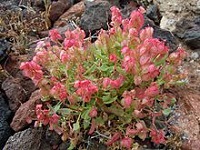Pharmacognostical Evaluation and Comparative Phytochemical Screening of Rumex vesicarius L.
Keywords:
Rumex vesicarius.L, pharmacognostic evaluation, phytochemical screening, Hot extraction, cold macerationAbstract
Pharmacognosy is a simple and reliable tool by which complete information of the crude drug can be obtained. Therefore in this context the detailed pharmacognostic study of various parts like leaf, stem, and root of Rumex vesicarius L. has been carried out with the aim to establish its pharmacognostical standards. The parameters selected were physicochemical, fluorescence analysis and preliminary phytochemical screening along with mineral analysis. In physico-chemical evaluation the ash values and extractive values were studied.. The powder of Rumex vesicarius.L was successively extracted with petroleum ether, chloroform, methanol and water by both cold maceration and hot soxhlet extraction for the identification of the best solvent and method. Preliminary phytochemical screening was carried out for all the extracts. Fluorescence analysis performed showed the wide range of fluorescence colours for the crude powder. The preliminary phytochemical screening shows maximum chemical constituents in the different extract obtained from cold maceration of different plant parts compared to extract obtained from hot soxhlet extraction. The principal constituents of Rumex vesicarius L. include phenols, tannins, flavonoids, saponins, triterpenoids, alkaloids, anthraquinones, quinines, reducing sugars, proteins, lipids and carbohydrates. The inorganic elementary analysis performed revealed the presence of sodium, chloride and iron. The present study indicates the pharmacognostical and physicochemical characteristics and preliminary properties of the different parts of Rumex vesicarius.L for the identification of the drug in the dry form. Thus plays a crucial role in standardization of crude drug.
References
Shankar D, Ved DK . Indian forester.2003;129:275-288.
Montvale NJ. PDR for Herbal Medicines. 1st ed. Medical Economics Company; 1998,
p. 1105-1107.
St. Louis MO. The review of natural products. 3rd ed. Facts and Comparisons; 2002,
p. 772.
Newall CA, Anderson LA, Phillipson JD. Herbal Medicines ; A Guide for health-care
Professionals: The Pharmaceutical Press, London; 1996, p. 274.
Ladeji O, Okoye ZSC,Waidu Z. Effect of supplementation of laboratory chow with leaf of Rumex acetosa (sorrel) on body weight and serum levels of amino acids and minerals in rats.Food Chem .1995; 59: 15-17. .
Ghosh L, Arunachalam G, Murugesan T, Pal M, Saha BP. Studies on the
psychopharmacological activities of Rumex nepalensis Spreng. root extract in rats and mice.
Phytomedicine. 2002; 9: 202-206.
Ghosh L, Gayen JR, Murugesan T, Sinha S, Pal M, Saha BP. Evaluation of purgative
activity of roots of Rumex nepalensis. Fitoterapia. 2003; 74: 372-374.
Demirezer L O¬, Kuruu¨zu¨m-Uz A, Bergere I, Schiewe H.-J, Zeeck A. The structures
of antioxidant and cytotoxic agents from natural source: anthraquinones and tannins from
roots of Rumex patientia. Phytochemistry. 2001; 58: 1213-1217.
Gebrie E, Makonnen E, Debella A, Zerihun L. Phytochemical screening and
pharmacological Evaluation for the antifertility effect of the methanolic root extract of
Rumex steudelii. J.Ethnopharmacol. 2004; 96: 139-143.
Getie M, Gebre-Mariam T, Rietz R, Ho¨hne C, Huschka C, Schmidtke M, Abate A,
Neubert RHH. Evaluation of the anti-microbial and anti-inflammatory activities of the
medicinal plants Dodonaea Viscose, Rumex nerVosus, and Rumex abyssinicus. Fitoterapia.
; 74: 139-143.
Rouf ASS, Islam M S, Rahman M T. Evaluation of antidiarrheal activity of Rumex
maritimus root. J. Ethnopharmacol. 2002; 84: 307-310.
Cos P, Hermans N, Bruyne T, De Apers S, Sindambiwe JS, Witvrouw M, Clercq E,
De Berghe DV, Pieters L, Vlietinck AJ. Antiviral activity of Rwandan medicinal plants
against Human immunodeficiency virus type-1 (HIV-1). Phytomedicine. 2002; 9: 62-68.
Yusuf MJ, Begum MN, Hoque and JU Chowdhury. Medicinal plants of Bangladesh.
BCSIR Chittagong; 2009, p.749.
Johanson DAO. Plant Microtechnique; Mc Grew Hill Book Co., New York. 1940.
Indian Pharmacopoeia, Government of India, Ministry of Health and Family Welfare,
Controller of Publication, 4th ed, New Delhi, 4(II);1996, A53-A54.
WHO/PHARM/92.559/rev.1, Quality Control Methods for Medicinal Plant Materials .
Chase C R and Pratt R S., Fluorescence of Powdered Vegetable drugs with
particular reference to Development of a System of Identification. J Am Pharmacol
Assoc. .1949; 38:32.
Kokoshi CJ, Kokoshi RJ and Sharma FT. Fluorescence of powdered vegetable
rugs under Ultraviolet radiation. J Pharm Asses.. 1958; 47:715-717.
Kokate CK, Khandelwal KR, Pawar AP, Gokhale SB, Practical Pharmacognosy,
Nirali Prakashan;1995; 1:11-19.
Harborne JB. Methods of extraction and isolation.,In: Phytochemical methods, 3rd
Ed., Chapman and Hall, London ;1998; 60-66.
Raghuramulu N, Madhava Nair K, Kalyanasundaram S. A manual of Laboratory
techniques : National Institute of Nutrition, Hydrabad; 2003, p.175-195.
Kumawat U and Shimpi S. Pharmacognostic studies of the Costus Pictus D.Don. Journal of herbal medicine and toxicology.2009;3(1):127-130.
African Pharmacopeia. General Methods for Analysis Is ted. 2: (OAU/STRC) Lagos. 1986; p.123
Musa KY, Katsayal AU, Ahmed A, Mohammed Z, Danmalam UH. Pharmacognostic investigation of the leaves of Gisekia pharmacioides. African J. Biotech. 2006; 5: 956-957.
Pimenta AM, Montenegro MC, Ara Ujo AN, Mart’inez JC. Application of sequential injections analysis to pharmaceutical analysis. J. Pharm. Biomed. Anul. 2006; 40: 16-34.
Banoti A. Problems relating to the preparation and use of extracts from medicinal plants. Fitoterapia.1980; 51: 5-11
Oluyemi EA, Akilua AA, Adenuya AA and Adebayo MB. Mineral contents of some commonly consumed Nigerian foods. Science focus. 2006; Vol-II. P.153-157.
Muhammad A, Dangoggo SM, Tsafe AI, Itodo AU and Atika FA. Proximate minerals and antinutritional factors of Gardenia aqualla (Gauden dutse) fruit pulp. In. Pakistan Journal of Nutritional. 2011;Vol -10,no.6; p.577-581.



